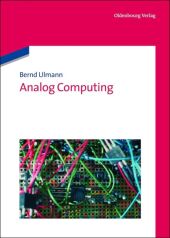 Neuerscheinungen 2013Stand: 2020-01-07 |
Schnellsuche
ISBN/Stichwort/Autor
|
Herderstraße 10
10625 Berlin
Tel.: 030 315 714 16
Fax 030 315 714 14
info@buchspektrum.de |

Bernd Ulmann
Analog Computing
2013. XIX, 300 S. w. figs. and tables. 240 mm
Verlag/Jahr: OLDENBOURG 2013
ISBN: 3-486-72897-0 (3486728970)
Neue ISBN: 978-3-486-72897-2 (9783486728972)
Preis und Lieferzeit: Bitte klicken
This book is a comprehensive introduction to analog computing. As most textbooks about this powerful computing paradigm date back to the 1960s and 1970s, it fills a void and forges a bridge from the early days of analog computing to future applications. The idea of analog computing is not new. In fact, this computing paradigm is nearly forgotten, although it offers a path to both high-speed and low-power computing, which are in even more demand now than they were back in the heyday of electronic analog computers. This first chapters of this book define the notion of analog computing and cover the early history of mechanical and electromechanical analog computers before focusing on the development and the basics of electronic analog computing elements and computers based on these. Two chapters give an introduction to the programming of analog computers with a number of detailed sample problems and solutions. These problems range from simple mass-spring-damper systems to predator-prey simulations and conformal mappings. The following chapters introduce the basic concepts of hybrid computers and digital differential analyzers, the latter of which offer an enourmous potential for future applications based on field programmable gate arrays (FPGAs) or the like. The second half of the book is dedicated to an overview of typical applications of analog computers based on a comprehensive bibliography. The last chapter describes future prospects for the analog computing paradigm.
This book is a comprehensive introduction to analog computing. As most textbooks about this powerful computing paradigm date back to the 1960s and 1970s, it fills a void and forges a bridge from the early days of analog computing to future applications. The idea of analog computing is not new. In fact, this computing paradigm is nearly forgotten, although it offers a path to both high-speed and low-power computing, which are in even more demand now than they were back in the heyday of electronic analog computers.
- The notion of analog computing - Mechanical analog computers - The first electronic analog computers - Basic computing elements - Analog computer anatomy - Typical systems - Programming - Programming examples - Hybrid computers - Digital differential analyzers - Applications - Future and chances
Bernd Ulmann, Jg. 1970, studierte Mathematik an der Johannes-Gutenberg-Universität Mainz und diplomierte über Zahlentheorie/Kryptographie. Er arbeitete einige Jahre als Software-Berater und leitete Kurse und Schulungen zu den Themen Programmierung, Betriebssysteme, Algorithmen und Datenstrukturen. Seit 1999 hält er Vorlesungen an der hessischen Verwaltungs- und Wirtschaftsakademie (VWA) und der Berufsakademie (BA). Seine Leidenschaft sind Analogrechner. 2009 promovierte er zu diesem Thema an der Universität Hamburg. Er hat seit Kurzem die Professur für Wirtschaftsinformatik der Fachhochschule für Oekonomie und Management in Frankfurt inne.


